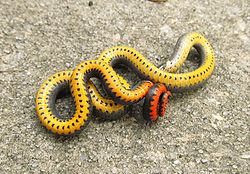Ring-necked snake
Diadophis punctatus, also called the ring-necked snake, is a species of snake. Ring-necked snakes live in eastern and central North America.[4] There are many colors and patterns of ring-necked snake. It is called the ring-necked snake because it has a stripe around its neck that looks like a ring.
| Ring-necked snake | |
|---|---|

| |
| Conservation status | |
| Scientific classification | |
| Kingdom: | Animalia |
| Phylum: | Chordata |
| Class: | Reptilia |
| Order: | Squamata |
| Family: | Colubridae |
| Genus: | Diadophis Baird & Girard, 1853 |
| Species: | D. punctatus
|
| Binomial name | |
| Diadophis punctatus (Linnaeus, 1766)
| |
| Synonyms | |
Ring-necked snakes live in the United States, central Mexico, and southeastern Canada. Ring-necked snakes are nocturnal, which means that they are awake at night. Ring-necked snakes are a little venomous, but they do not hurt people. This is because they are small and do not bite people much. When ring-necked snakes are scared, they curl up their tails.
Scientists think that there are many ring-necked snakes. Scientists do not know exactly how many ring-necked snakes there are. This is because scientists have not studied ring-necked snakes very much.
Ring-necked snakes are the only species of snake in their genus. There are 14 subspecies of ring-necked snake.
Description
Ring-necked snakes are usually dark-colored, with a bright stripe around their necks.[5] [6] Ring-necked snakes that live in different areas may look different. Their heads are usually darker-colored than the rest of their bodies. [6]
Snakes living in different areas are often different sizes. Adults are usually 25–38 cm (10–15 in) long. [5] Young snakes less than a year old are usually about 20 cm (8 in) and grow about 2–5 cm (1–2 in) a year.[6]
Ring-necked snakes have smooth scales with 15–17 rows of scales in middle of their bodies.[5]
Habitat
Ring-necked snakes live in many kinds of habitats. The[6] Northern and western subspecies live in open woodlands near rocky hills, or in wetter environments with many places to hide.[5] Southern subspecies mostly live in riparian and wet environments, especially in more arid, or dry, habitats.[6] The snakes like it when their habitat is a little wet. [5] Ring-necked snakes do not live higher than 2,200 m (7,200 ft) above sea level.[5] In northern areas, ring-necked snakes may live in dens. Usually, more than one snake will live in one den.[6] Ring-necked snakes often hide under pieces of wood. When it is hot, ring-necked snakes may make holes and burrows to hide in. They may also hide under rocks or other objects. Ring-necked snakes usually live in flatland forests.
Diet
Ring-necked snakes mostly eat salamanders, earthworms, and slugs. They sometimes eat lizards, frogs, and some young snakes of other species.[6] Ring-necked snakes in different habitats may eat different amounts of some species.[6] Ring-necked snakes kill their prey with constriction, which is squeezing prey to kill it, and envenomation, which is using their venom.[7] Ring-necked snakes usually don't try to hurt bigger animals. Instead of biting bigger animals, the snake curls up its tail, showing its brightly colored stomach.[6]
Predators
Coral snakes, kingsnakes, and racers are predators of ring-necked snakes. Sometimes, large spiders or centipedes will eat young ring-necked snakes.[8]
Subspecies
There are 14 subspecies of ring-necked snake.[3]
Gallery
Ring-necked Snake Media
Ring-necked snake from Mount Diablo, California
References
| Wikimedia Commons has media related to Lua error in Module:Commons_link at line 62: attempt to index field 'wikibase' (a nil value).. |
| Wikispecies has information on: Ring-necked snake. |
- ↑ Hammerson GA, Frost DR (2007). "Diadophis punctatus". The IUCN Red List of Threatened Species. IUCN. 2007: e.T63769A12714288. doi:10.2305/IUCN.UK.2007.RLTS.T63769A12714288.en. Retrieved 10 January 2018.
- ↑ Stejneger L, Barbour T (1917). A Check List of North American Amphibians and Reptiles. Cambridge, Massachusetts: Harvard University Press. 125 pp. (Diadophis punctatus, p. 76).
- ↑ 3.0 3.1 "Diadophis punctatus ". The Reptile Database. www.reptile-database.org.
- ↑ Yung, James. "Diadophis punctatus (arnyi)". Animal Diversity Web.
- ↑ 5.0 5.1 5.2 5.3 5.4 5.5 Stebbins RC (2003). A Field Guide to Western Reptiles and Amphibians, Third Edition. The Peterson Field Guide Series ®. Boston and New York: Houghton Mifflin Company. xiii + 533 pp. ISBN 978-0-395-98272-3. (Diadophis punctatus, pp. 345–346 + Plate 46 + Map 133).
- ↑ 6.0 6.1 6.2 6.3 6.4 6.5 6.6 6.7 6.8 Yung, James (2000). "Diadophis punctatus arnyi ". Animal Diversity Web. Retrieved 2009-10-01.
- ↑ O'Donnell RP, Staniland K, Mason RT (2007). "Experimental evidence that oral secretions of Northwestern Ring-necked Snakes (Diadophis punctatus occidentalis) are toxic to their prey". Toxicon 50: 810–815.
- ↑ Yung, James. "Diadophis punctatus (arnyi)". Animal Diversity Web. Retrieved 2018-12-23.








